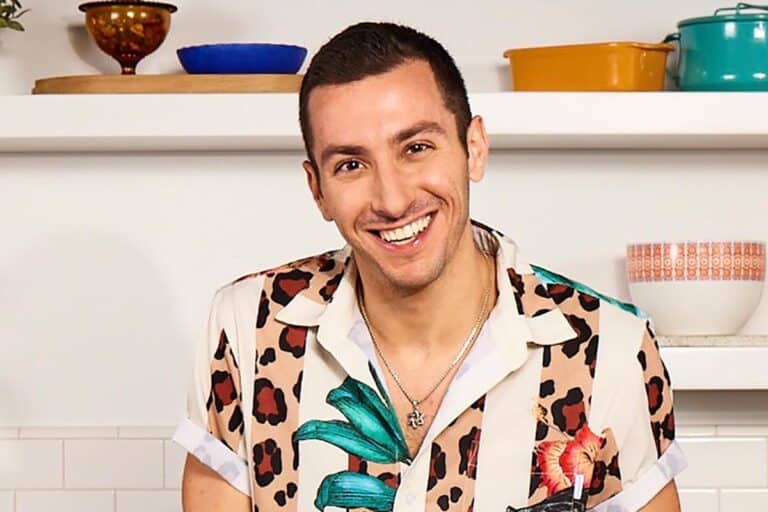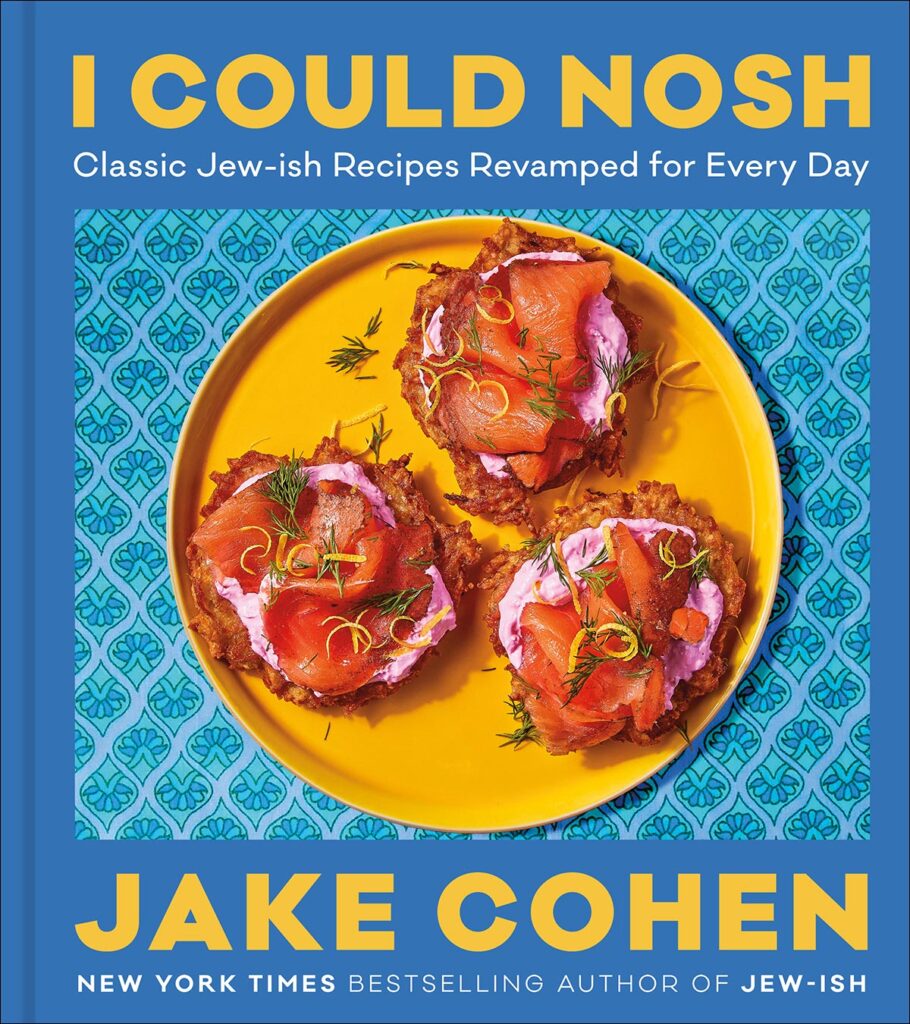
Everything that Jake Cohen cooks is rooted in authenticity, from his Jewish heritage to his personal cooking style.
The 30-year-old chef and cookbook author has built a massive online platform where he shares recipes related to his Jewish heritage, including meals for Shabbat.
Cohen, who boasts over 1 million Instagram followers and 1.5 million on TikTok, often shares videos that elevate and modernize Jewish cooking. The New Yorker’s focus is providing accessible recipes for home chefs looking for something that could be made for any occasion.
The two-time New York Times bestselling author of “Jew-ish: Reinvented Recipes from a Modern Mensch” and the recently-released “I Could Nosh: Classic Jew-ish Recipes Revamped for Every Day,” shares family recipes — like his great-grandmother’s apple cake — and his own, like pumpkin spice babka.

Unpacked spoke to Cohen to discuss the need for innovative Jewish cooking, creating new Shabbat traditions, and why he believes cooking is a great way to connect to one’s Judaism.
Craving Jewish comfort food? Try Jake Cohen’s harissa tomato bisque with challah grilled cheese
Jake Cohen’s recipes are inspired by his Jewish upbringing
As Cohen shifted from roles in test kitchens and as a food critic to becoming a cookbook author and content creator, he knew he wanted to center Judaism at the heart of his work.
Many of the recipes Cohen shares — like challah, rugelach and matzo ball soup — are inspired by food that he ate at family meals growing up.
Get Jake Cohen’s famous recipe for chicken soup with matzo balls
Each of Cohen’s recipes is accompanied by an anecdote, many of which are shared on his social media and his cookbooks. He often recalls memories associated with the food or the people he prepared the meal for. Cohen believes that there is a unique story behind every dish, shaped by various influences.
Growing up in Queens and Long Island, Cohen was surrounded by Jewish cooking at every holiday. While working at a test kitchen for a magazine, he loved sharing his family’s recipes and became passionate about showcasing his Jewish cooking.
@jakecohen MARBLE-GLAZED HANUKKAH COOKIES!!! Santa WISHES he could get his hands on these! One of my fav cookie recipes kissed with almond extract and so GORG! Recipe in I Could Nosh, ofc. You better be planning on lighting candles and noshing on latkes every night this year, it’s never been more important!!!! 💙✡️💙 #hanukkah #cookies #jewish
♬ Ma’oz Tzur (feat. Nicolette Robinson) – Leslie Odom Jr.
This was soon reflected in his innovative uses of schmaltz and new flavors of babka. “Sharing food really has to be rooted in authenticity. And for me personally, it’s such a huge part of who I am, my upbringing,” Cohen shared with Unpacked.
In addition to recipes that reflect his Jewish heritage, Cohen also shares a variety of pasta, cakes and breakfast options.
@jakecohen THE BEST BRISKET YOU’LL EVER MAKE!!! GET THIS RECIPE & OVER 100 MORE IN MY NEW COOKBOOK, I COULD NOSH!!! LINKS IN MY STORY HIGHLIGHTS AND BIO TO ORDER!
♬ cozy vibes – RyseMusic
“There are some dishes that I hold more sacred based on my upbringing and the meaning that they have for me through the lens of hospitality. There are other dishes that I have more fun with because I don’t have a deeper connection with them,” Cohen said.
Cohen views cooking as a way to connect to Judaism and deepen relationships
The author began to integrate more Mizrahi flavors into his recipes when he married his husband, Alex Shapiro. Cooking with Shapiro’s grandmother, Cohen learned about their family’s Persian-Iraqi traditions.
The Ashkenazi fare of Cohen’s childhood was extremely different from the flavors at Shapiro’s table. Cohen said that sharing those different traditions helped the couple understand each other’s backgrounds, and their Shabbat table soon became a mix of the different cuisines.
“We’re of the same religion and yet have completely different cultures, which are both incredibly vibrant,” he said.
Cohen’s recipes are inspired by actual dishes he serves at his star-studded Shabbat table — with guests like Jewish music producer and fellow cookbook author Benny Blanco and Broadway comedian Alex Edelman.
“My new recipes are a representation of the Shabbat practice that I started with my husband, creating a table of our own to build relationships and deepen connections,” Cohen explained. “I think these are really fun recipes that represent tradition and modernity.”
Understanding each other’s backgrounds through sharing culinary traditions is an “incredible exercise that we try to do with not only each other but everyone else that we meet. It’s a really great way to get to know someone and embrace the things that they hold nearest and dearest,” he added.
Cohen’s cookbooks blend Jewish tradition and innovation
Shapiro’s background inspired Cohen’s Persian-style latkes and traditional Iraqi beet kubbeh soup, both featured in his first cookbook.
Cohen’s approach involves creating new takes on traditional recipes that his great-grandparents might have made, adapting them for a modern lifestyle.
He believes that cooking is a dynamic and evolving practice, with recipes continuously adapting to reflect changing tastes, ingredients and cultural influences. He sees the fusion of Jewish cuisine with other culinary traditions (in recipes like “cacio e pepe rugelach” and “chall-zones”) as a continuation of innovation practices that have existed for thousands of years.
“The evolution of any diaspora cuisine, especially Jewish food, is that Jews have continued to evolve their cuisine to whatever area that they live in, the ingredients that are native, absorbing [traditions] from their neighbors. I’m just continuing that tradition through the lens of New York and modern cooking,” he explained.
Cohen wants to challenge preconceptions about Jewish cooking
Over the years, Cohen has seen remarkable similarities between Jewish cooking and other cuisines. When he travels, he often seeks inspiration from local cuisines and mulls over how to blend them with Jewish cooking or infuse them with the flavors of New York City.
“You start to see similarities because at the root of all cuisines, there are parallels in terms of techniques or ingredients. There’s something super fun about being able to see our similarities with other people,” he added.
@jakecohen RAINBOW-TASHEN!! Same recipe with a little pop of color just because I want my cookies as extra as I am!!!! All you do is divide the dough in 4 and knead your preferred food coloring in each before smooshing pieces of alternating colors together and rolling between sheets of parchment! You can still reroll scraps!! Happy Purim!!!! Lemon-Poppy Frangipane Hamantaschen Yield: about 20 hamantaschen For the Filling: 1¼ cups almond flour ½ cup sugar ¼ cup poppy seeds 2 tablespoons unsalted butter, melted 2 teaspoons lemon zest 1 teaspoon almond extract ½ teaspoon kosher salt 1 egg For the Dough: 1 cup (2 sticks) unsalted butter, softened 1 cup granulated sugar 1 large egg 1 teaspoon vanilla extract 1 teaspoon kosher salt 3 cups all-purpose flour (405g) 1. Make the filling: In a medium bowl, stir all the ingredients until a smooth paste forms. 2. Make the dough: Line two sheet pans with parchment. In the bowl of a mixer fitted with the paddle attachment, cream the butter and sugar until light and fluffy. Add the egg, followed by the vanilla and salt, mixing until incorporated. Add the flour (YOU BETTER USE A SCALE OR NOT OVERPACK YOUR CUPS) and mix on low until a smooth dough forms. (IT’S CRUCIAL YOUR DOUGH IS MIXED ENOUGH TO MAKE ONE BALL, IF STILL CRUMBLY MIX MORE!) 3. Transfer the dough between 2 sheets of parchment and roll out to ¼-inch thick. Using a 3¼-inch ring cutter, cut out as many circles of dough as you can. Spoon 1 scant tablespoon of filling into the center of each circle of dough. Fold in the dough from three sides and pinch the edges together to seal, leaving a small opening over the filling. Place the hamantaschen on one of the prepared baking sheets. 4. Reroll the dough scraps and repeat the process to form as many hamantaschen as you can. Chill the hamantaschen for 1 hour. Meanwhile, preheat the oven to 350°F. 5. Divide the chilled hamantaschen between the two prepared pans, spacing them 2 inches apart. Repinch the corners to ensure they’re well sealed. 6. Bake , rotating trays halfway through, for about 20 minutes, until the bottoms and corners are golden. Let cool, then serve. #purim #hamantaschen #jewish
♬ The Four Seasons, Concerto No. 4 in F Minor, Op. 8, RV 297 “Winter”: I. Allegro non molto – Antonio Vivaldi
Cohen believes that Jewish food is too often relegated to cuisine for Jewish holidays, rather than integrated into everyday fare. One of his goals for “I Can Nosh” is to challenge this by showing how Jewish cooking and flavors can enhance everyday dishes.
Another misconception Cohen hopes to dispel is the idea that Jewish cooking is bland and flavorless, a stereotype associated with Ashkenazi food. Cohen emphasized that the Jewish people are incredibly diverse and their food is representative of that.
“There’s vibrant [Jewish] cuisine that has survived throughout both hardship and complete displacement and continues to stand the test of time, and I think that’s absolutely magical,” he said.
Cohen hopes to create spaces for people to enjoy Jewish cooking
Later this month, Cohen will be taking Jewish cooking to the South Beach Wine & Food Festival. He is hosting a sit-down dinner, which will be prepared alongside fellow social media star Olivia Tiedemann and Food Network juggernaut Robert Irvine, to kick off the event’s FoodieCon.
The sit-down dinner promises to be not only delicious but also an Instagram-worthy display of beauty. (“People eat with their eyes,” Cohen said on the importance of aesthetics in cuisine. “The way that you tell a story is so important, but one doesn’t exist without the other. Pretty food doesn’t mean anything unless it’s delicious.”)
Cohen’s contributions to the meal include a fried potato kugel and a challah bread pudding. He wanted to highlight Jewish cooking at the event since it showcases the best the food world has to offer, and he knew Jewish food needed a place in that.
@jakecohen CHALLAH MONKEY BREAD!!!! Did you save some dough today to make the easiest and most show-stopping dessert????? Part of an entire section in my book about how to flavor challah dough and all the things you can do with it!!! GET THIS RECIPE & OVER 100 MORE IN MY NEW COOKBOOK, I COULD NOSH!!! LINKS IN MY BIO TO ORDER! #icouldnosh
♬ come into my arms – november ultra
Cohen, who is currently working on his third cookbook, emphasized that he has no interest in starting a restaurant.
To him, the magic of cooking is seeing someone’s reaction to eating his food. The highlight of Cohen’s career has been witnessing the impact of his cooking on home chefs, seeing how they integrated parts of his recipes into their holidays and daily routines.
“The more I dove into food, the more I understood these recipes are truly made for the idea that you get to engage your family, friends and community to create space for [meaningful] conversations…I only really want to create spaces that can be tied to both my Judaism and food as a connector,” Cohen said.
Originally Published Feb 14, 2024 11:29PM EST
